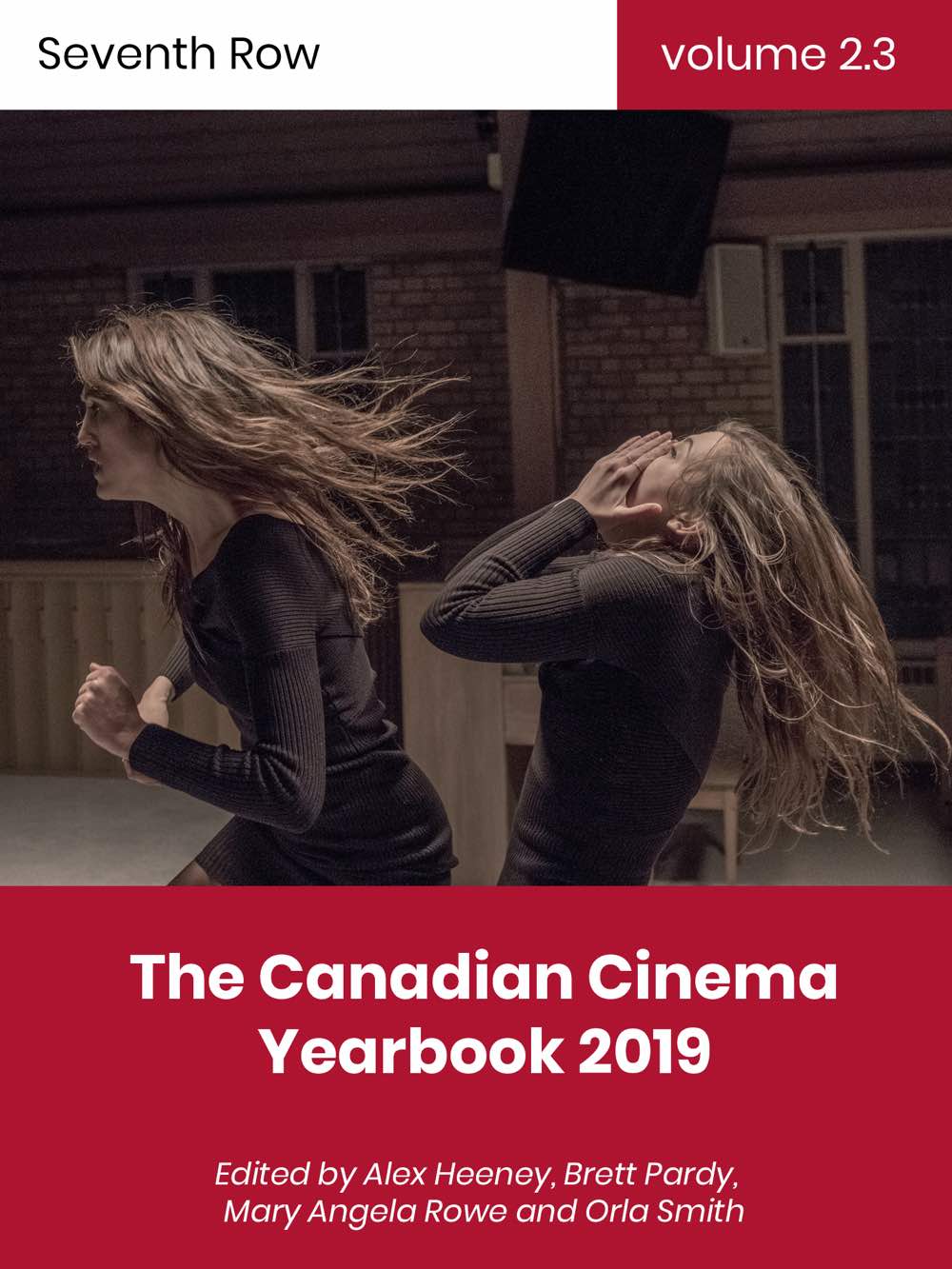Stéphanie Anne Weber Biron was recently nominated for a Canadian Screen Award for Nadia, Butterfly. We speak to her about shooting that film and Andrea Dorfman’s Spinster.
Read our interview with Nadia, Butterfly director Pascal Plante.
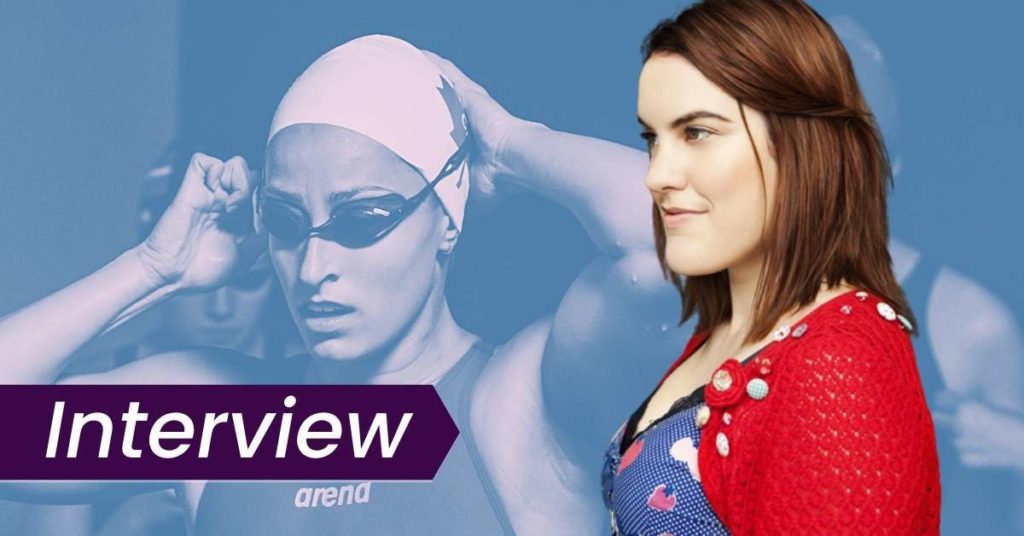
Discover one film you didn’t know you needed:
Not in the zeitgeist. Not pushed by streamers.
But still easy to find — and worth sitting with.
And a guide to help you do just that.
There are few emerging cinematographers more exciting than Stéphanie Anne Weber Biron, who brought immersive visuals, rich colours, and astounding technical skill to the equally beautiful and vastly different Spinster and Nadia, Butterfly last year. The Québécois DP was recently nominated for her third Canadian Screen Award for her work on Nadia, Butterfly, and rightly so. It’s a film that’s just as impressive for how emotional its visuals are as it is for the technical ingenuity it took to pull off the film’s swimming set pieces.
Weber Biron’s name is attached to many of the most visually striking Canadian films of the last decade, from Guy Maddin and Evan Johnson’s The Forbidden Room, to Andrea Dorfman’s Heartbeat. Her feature film career began with Xavier Dolan’s I Killed My Mother. Both Dolan and Weber Biron were newbies to the film industry at the time, and many cinematographers were reluctant to work with the young and inexperienced Dolan on such a low budget film. Weber Biron said yes, and the gamble paid off. She went on to shoot Dolan’s second film Heartbeats (not to be confused with Dorfman’s Heartbeat) and gain international attention for her visually striking work on both of Dolan’s films.
Nadia, Butterfly was certainly Weber Biron’s most ambitious cinematographic feat of 2020. The film opens with two astounding “how did they pull this off” swimming scenes set at a fictional Tokyo 2020 Olympics. In a single take, the camera follows protagonist Nadia (Katerine Savard, a real-life ex-Olympic swimmer) up and down the pool in a swift, gliding motion. When we interviewed director Pascal Plante, he described how he and Weber Biron pulled off these swimming sequences: “The camera was rigged on a pulley system so we [could] capture both ends of the pool. [Weber Biron] was physically in a swimsuit on a paddle board so she could operate the camera.” When I asked her about this contraption, Weber Biron’s account of operating a camera on a floating longboard made me greatly admire her balance.
What’s most impressive about the cinematography in Nadia, Butterfly isn’t just its technical achievement, but the way Weber Biron subtly immerses us in Nadia’s subjective headspace. Plante (an ex-swimmer himself) talked to us about how he worked with Weber Biron to visualise the viewpoint of a swimmer. They used vintage lenses to play with imperfections in the image, like the feeling “when you’re wearing goggles, and you remove the goggles, and you have this blur of water in your eyes.” Just like in Spinster, Weber Biron captures bold colours that pop off the screen, particularly the blue of the water and the red of the Canadian swim team’s costumes — colours that are central to Nadia’s world.
Andrea Dorfman’s latest film, Spinster, is a less visually flashy film, but no less distinctive or beautiful. It’s an “anti-rom-com” in which protagonist Gaby (Chelsea Peretti) learns to appreciate single life rather than falling in love, but Weber Biron ensures that we still get all the warm and fuzzy rom-com feels the genre demands. In fantasy sequences that show Gaby’s (and other people’s) idealised fantasy version of love, Weber Biron uses woozy, soft closeups and lingering shots of body parts to visualise desire. When Dorfman snaps us back into Gaby’s more mundane reality, Weber Biron’s cinematography is less showy, but the colours still pop, creating an appealing and comforting world you just want to live inside.
In the wake of her Canadian Screen Award nomination, I spoke with Weber Biron about how she fell in love with cinematography, why she’s interested in making films about “the underdog and underrepresented people,” and how she gets her films to be so colourful.
Seventh Row (7R): What attracted you to cinematography?
Stéphanie Anne Weber Biron: I’ve always been interested in photography. I remember being a little kid and my dad had a 35 mm manual photography camera. As a five year old, [I loved] the feeling of looking through the viewfinder and adjusting the focus on the lens. I was really fascinated by the camera. I started taking photos, and my dad gave me my own little camera, a way less sophisticated one.
And then, I fell in love with cinema. As a teenager, I haphazardly discovered independent film. Before then, I had mainly been exposed to Hollywood movies and some French movies, because we do get a lot of French movies in Quebec. But I randomly rented a Jim Jarmusch film when I was fifteen, and it really blew my mind, like, “Whoa, cinema can be so interesting and cool.”
After high school, I chose a communications program, so we were studying photography, film, theatre. In my photography classes and cinema classes, I put those two loves together.
7R: What was the Jim Jarmusch film?
Stéphanie Anne Weber Biron: I think it was Night on Earth (1991). As a teenager, I liked Winona Ryder. So I’m like, “Oh, yeah, I’ll rent this because it’s got Winona Ryder in it.” But I was expecting just a typical Hollywood film, and that’s not what I got. My mind was blown. I started renting all of his films after that.
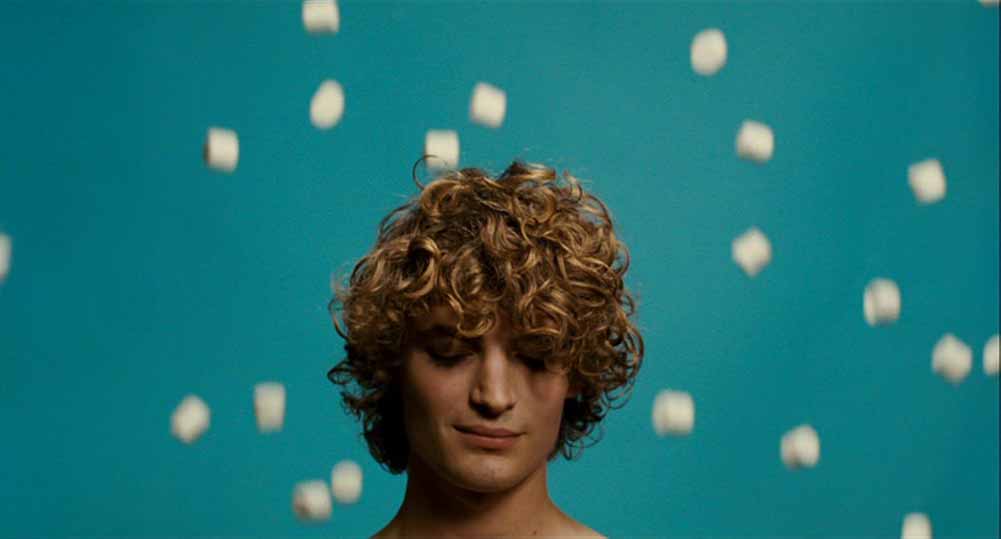
7R: Your first fiction feature was I Killed My Mother by Xavier Dolan, which was super, super low budget. How did you get involved with that project?
Stéphanie Anne Weber Biron: Xavier had approached many cinematographers who all turned him down because he had never done anything as a filmmaker before, and because the budget was so dire. For the actual shooting, it was something like $100,000. Later on, he got grants to finish the movie and retroactively paid people a bit better. But what they were offering people as a salary was very symbolic. And not only [because of the pay], but no one wanted to take the risk of making this film which might look crappy [because it was low budget].
I read the script, and I thought it was very strong. I met him, and I saw right away that he was super passionate about filmmaking. He had a really clear, interesting vision.
7R: What attracts you to a project? I assume it’s changed a little bit since then.
Stéphanie Anne Weber Biron: Unfortunately, there is the reality of earning a living, so sometimes, I’ll take a project on even if it’s not exactly my cup of tea. Also, I want to keep honing my craft. It would be unrealistic for me to only accept jobs that I absolutely adore. But of course, with time, it’s going more in that direction. When I started out, I couldn’t be as picky as I am now.
What attracts me to a project is the feeling that I have a vision that can align itself with the vision of the director — if we see the script in a similar way [regarding] how we should approach it visually.
I am attracted to scripts where women are portrayed in an interesting way and are not superficial. I prefer if I can support a feminist and not-degrading view of women. I guess I do like stories about the underdog or underrepresented people. Anything that shows a more inclusive vision of the world, which was why I was very happy to work with Xavier as a gay director. And I work with a lot of women directors.
It’s definitely more fulfilling for me if I have the impression that I can be creative with the cinematography. I want my cinematography to support the story and the emotions, to be a visual way of expressing what the characters are feeling,
Nadia, Butterfly
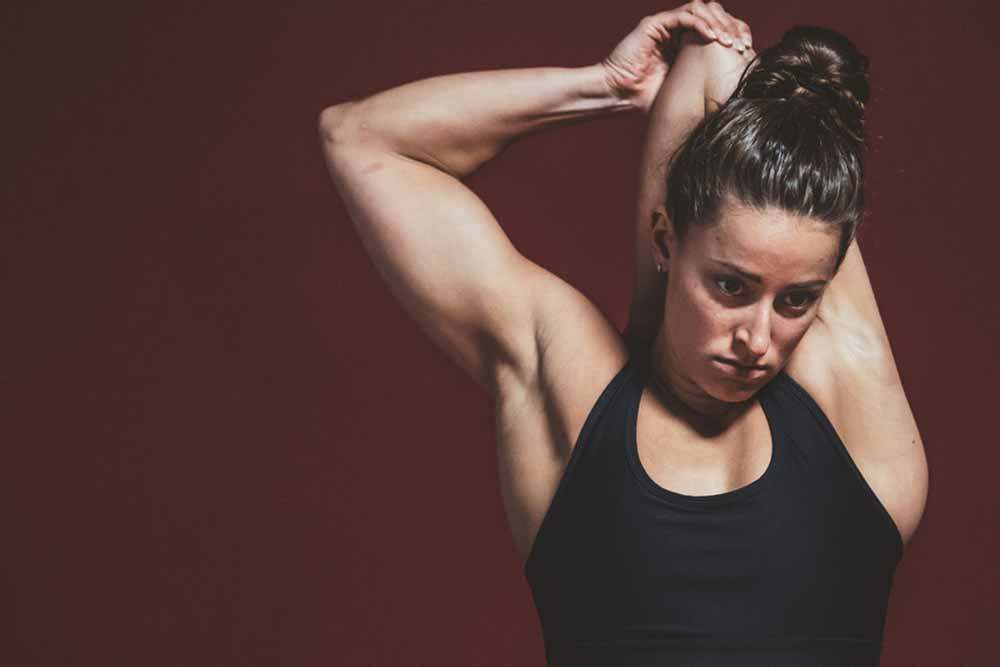
7R: What attracted you to working with Pascal Plante on Nadia, Butterfly?
Stéphanie Anne Weber Biron: A while ago, I worked on a documentary about ballerinas, and one of the things that occurred to me is how short-lived their professional careers are. That’s the same thing with athletes. When you choose a career like that, it’s so intense, and you focus all your energy on being an athlete or a professional dancer. It’s so rigorous. And then you have to retire at the age of thirty or thirty-five. What do you do with the rest of your life? I found that question so fascinating. You could tell by reading the script that Pascal knew that world and did his research.
What really sold it to me is when I met with Pascal. He’s such a nice guy. He knows what he wants but he is also very open and was encouraging me to be very creative and free. He came on board with all my quirky ideas, like filming through a small aquarium that I asked my assistant to build. [We did] some old school in-camera effects. That’s always really fun for me.
I also wanted to play with water motifs, since water is an important element in the film, because [Nadia is] a swimmer. I wanted to have water reflections in the lighting sometimes. Pascal was super open to those kinds of ideas. Not every director is, because it is a little bit bold. It’s not subtle. But I always wanted it to be justified; I got the art director to add a huge aquarium in the party scene so that when I do my reflections of water on the wall, it’s more justified. But other times, it’s good to be able to take liberties [with reality in favour of] what’s interesting cinematically and poetically.
A lot of films in Quebec, I find, are more minimalistic or realistic. They don’t want the cinematography to attract attention. I understand that. I don’t want the cinematography to attract attention in a negative way. I don’t want it to make you come out of the story. But I think if you’re translating an emotional connection to the script and to the characters into visuals, and if you’re coherent with the style throughout, then you can allow yourself little fantasy moments.
7R: A lot of the films you’ve shot, including Nadia, Butterfly and Spinster, have been single-protagonist character studies. The visuals are quite subjective to the character. Why does that subjectivity appeal to you in character studies?
Stéphanie Anne Weber Biron: I always have that conversation [with the director]. I prefer the visuals to reflect the character’s inner turmoil or emotions. But often, in the same film, you can notice certain scenes where I’m more objective, because I want the story to still be the centerpiece. There’s moments where you just have to step back and let the characters and the script be centerfold.
And then other moments, like the dream sequence [in Nadia, Butterfly, where that isn’t the case]. You can totally put some smoke in the background while she’s swimming in the pool because it’s a dream sequence; it’s poetic, and it’ll work. The visuals are as much a part of the experience as the sound and the music and the script and the dialogue, so why not have this beautiful image?
7R: What does your typical prep process look like? Did that differ with Nadia, Butterfly?
Stéphanie Anne Weber Biron: It varies a little bit from director to director, but I really do like being involved in the shot list. [I like to go] through every scene with the director and try to imagine how we want to shoot it, and even imagine it edited.
I often work on films that are relatively low budget. We often don’t have a lot of time. On Nadia, Butterfly, I think we had sixteen days of shooting, which is not a lot for a feature film. The last thing I wanted to do was waste time filming unnecessary shots. That’s why I really like to dive in deep and imagine, “Okay, well, likely we will only want to use this wide shot at the beginning of the scene or in the middle.” And then you don’t have to shoot the whole scene if it’s long.
We often use references, maybe inspirations from other movies or photography or art, in terms of what kind of lighting and contrast and colour palette [we are going to use]. I like to come up with a sort of bible for each film: what’s our approach for this film? For example, on a film called Blackbird (2012), which I shot a long time ago, our approach was that we always want to show the main character’s perspective. We always want to focus on him. That’s exactly what we did for Nadia, Butterfly.
There are certain things that Pascal already knew. He had a clear vision of the beginning of the movie: he knew he wanted to do a long dolly. Early on, we also discussed how we didn’t want to film any of the races in typical Olympic Games-style coverage, where they have so many cameras all over the place, and they show you all these cool angles. We wanted to have long takes and a single camera to really feel like you’re there with the athletes, from a different perspective than what we’re used to seeing.
7R: I feel like a lot of the films that you’ve shot have been really bold and colourful. That’s the case with Nadia, Butterly, with Spinster, and with Xavier Dolan’s Heartbeats. The colours really pop. Why is that something that you enjoy visually? And how do you achieve it?
Stéphanie Anne Weber Biron: If a director tells me they want a colourful film, the first thing I say is, “Well, you better get the art department and the costume department on board because there’s only so much I can do if you give me rooms with white walls and characters wearing gray.” It really makes a huge difference.
I can also add [colour with lighting]. There’s a party scene in Heartbeats, the Xavier Dolan film, where the wall was white in the background. We wanted something more colourful; I threw a colourful light on the wall so it looked pink. I did that a lot in Nadia, Butterfly, with a lot of aqua blue lighting and some little touches of red here and there in the lighting itself. But then, a lot of the colour comes from the sets.
The red was for Canada, since it’s the Olympics, and it’s the colour of the Olympic team. The blue is to represent water. Her whole life has been so centered on training and spending so much time in pools.
For Spinster, I’ve worked with Andrea Dorfman before. She’s become a good friend. She does animation films, and not only in her art, but in her life, she’s a very colourful person. She embraces colour. She’ll wear bold colours. So do I! I love colour. But not in every film. Some films would not be well served with a colourful palette. Blackbird is an example where there’s definitely a colour palette, but the colours are not as saturated. Blue is an important colour in Blackbird, but you’ll see it’s a more desaturated blue.
Sometimes, it evolves, like in Andrea Dorfman’s previous film before Spinster, Heartbeat, there is a progression. The character, at first, feels a bit lost. She doesn’t know what to do with her life. She’s just living in the house that her grandmother left her and wearing her grandmother’s old clothes. She’s in search of identity, and she’s doing a job she doesn’t like. For the first half of the film, when she feels more lost, there’s less colour. And then, as we go through the film, there are more and more pops of red and bold blue and other colours.
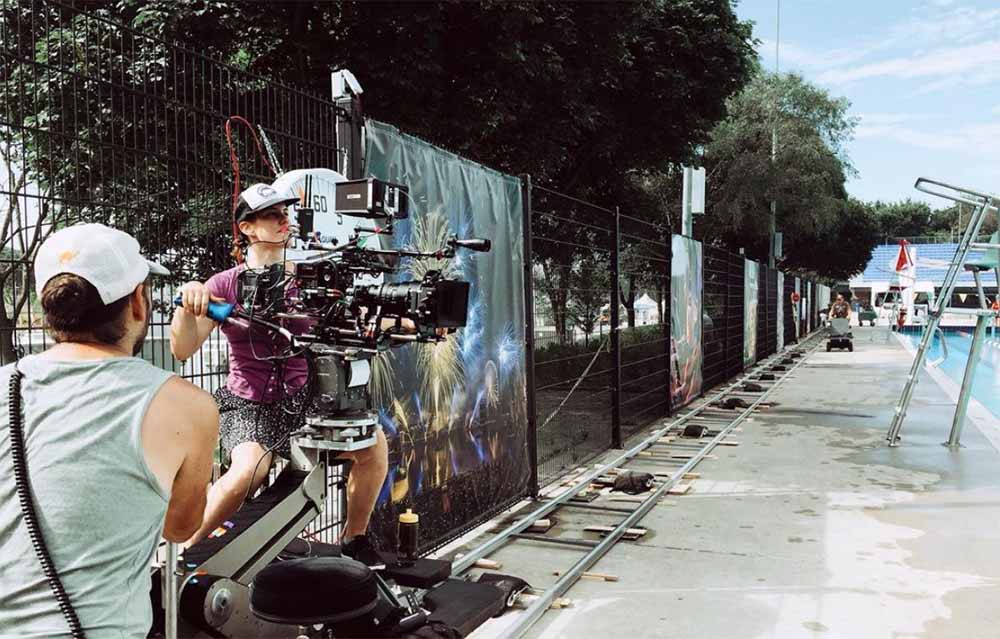
7R: Can you tell me more about shooting the swimming scenes in Nadia, Butterfly? When we interviewed Pascal, he said that he wanted both swimming scenes in the film to have their own unique visual styles. I imagine pulling those scenes off must have been quite technically challenging.
Stéphanie Anne Weber Biron: The very first scene of the film is a long dolly back and forth, and also a zoom in. That was the very first scene we shot. That also was a very clear vision that Pascal had for that shot, and I loved it. I was on board. It’s a very technically challenging one because of the time [it takes] to lay fifty feet of tracks, since the swimming pools are big, and then rehearsing it with a big zoom. But it’s fun. I love it.
The biggest challenge is that we couldn’t do those scenes many times, because the athletes would get exhausted. So I would just rehearse on my own with my crew, like my focus puller and my dolly grip, to get the feel of the movement. And then, we just went for it.
The second [swimming scene] was the most challenging one. It was the actual [relay] race, which happens [a few scenes] later. Initially, we wanted to do the whole scene in one take. We could have done that if we had more days of shooting. We would have needed a full day to rehearse [before actually] shooting it. But we had a whole bunch of other scenes to shoot that day. The technically difficult part is that a lot of that scene happens outside of the pool, before the race. And then, at one point, she dives [into the water to start her leg of the race].
I asked my crew to come up with a device that could allow me to go from the side of the pool to a floating device right on the pool. But because when she dives, she just goes so fast, I would have had to dive myself. It was just too technically challenging to do the way we wanted it.
There’s ways that you could have done that a bit more traditionally, like being on a dolly on the side of the pool with a crane or something. But what was the most important, more than it being a oner, was that we wanted to be physically close to the water for the part where she’s swimming. That’s why we decided to compromise and have one shot for the whole part before she dives, and then cut to a different shot] when she dives. The camera [and me] are on the surfboard, and my grips are pulling rope to make the surfboard go really fast. I say surfboard, but it was more like a floating longboard which they were pulling. That was challenging, because we only got one take.
7R: I saw the film a couple months ago, and if you had told me that that whole sequence was a oner, I would have believed you. It feels so intense and in the moment.
Stéphanie Anne Weber Biron: That’s really what we wanted. The only cheat is that we cut for this board shot. Everything else is one take. It’s one take before she’s in the pool, one take in the pool, and [a final] take outside of the pool when she comes out. But there are no other cuts. It gives you that sense of real time.
7R: I’m trying to picture the filming setup in my head. Wasn’t there a danger of the board tipping into the water?
Stéphanie Anne Weber Biron: Yeah, of course. The camera was in a waterproof bag. So even if it fell in, it would have survived.
7R: So you just had to make sure you were super balanced?
Stéphanie Anne Weber Biron: Yeah. I had the most ungraceful position on that board. I was wearing a bathing suit. I was like, “Do not look at me while I work!”
7R: I also really love what happens right after that scene, where we see Nadia changing out of her bathing suit after the race. She goes into a blue tent, and she is crying. We see the silhouettes of her teammates’ hands appear around the tent, comforting her. It was this really lovely visual representation of where the character is at: she’s lonely, but she has the comfort of her teammates around her.
Stéphanie Anne Weber Biron: That’s another example where colour was important. We had to choose what colour the tent that she’s changing in is. It wouldn’t have felt right if it was red, even if red is the colour of Canada. Blue felt like the right mood. visually.
That [scene] was Pascal. It was written in the script. I just had to make sure to light in a way that we could see the silhouette of the hands properly through the material. That’s something else where, again, you have to coordinate with the art director, or else she may have found some kind of tent that light couldn’t pass through well enough.
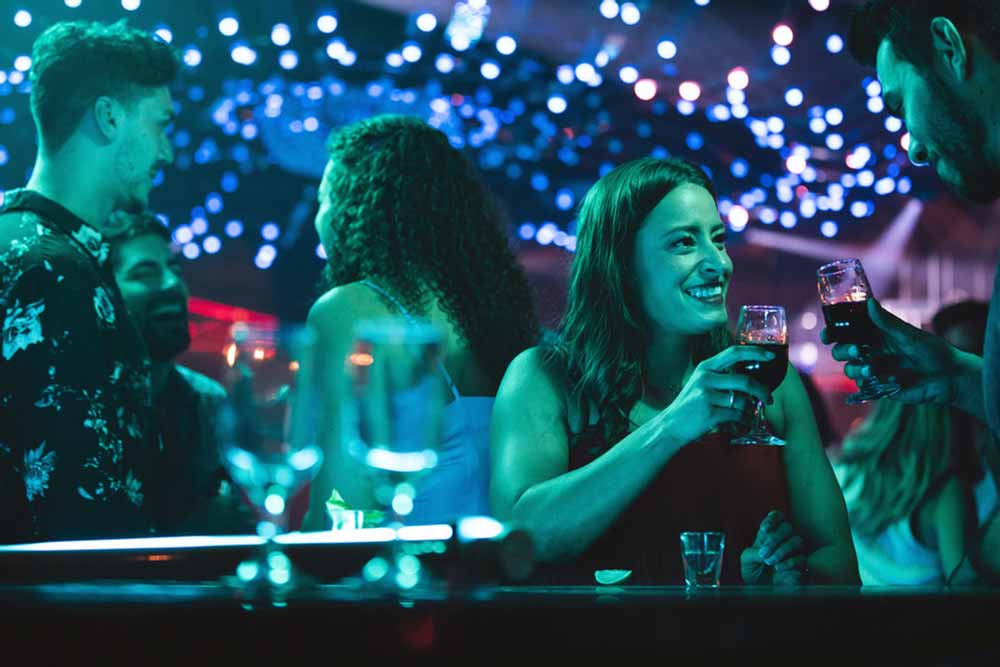
7R: I love the long sequence in the middle of the film, after the race, where Nadia and her friend go out for a night on the town in Tokyo. It’s such an exciting and energetic sequence. How did you decide to shoot it?
Stéphanie Anne Weber Biron: The challenge for those sequences was that, obviously, the film takes place in Tokyo, but we only shot three days or two-and-a-half days in Tokyo. Everything else is shot in Montreal. So everything that you see outside is actually in Tokyo, shot guerilla style, with just me, my camera assistant, Pascal, the producer, and the sound person that we hired in Tokyo. Plus, [we had] a friend of mine who’s actually a really great, independent Japanese filmmaker called Daisuke Miyazaki. He actually hired his real crew, like his producer and his cinematographer, just to be our advisors. They would drive us around. It was all about trying to keep us safe, because we weren’t supposed to be filming. We had permits for certain little things in Japan, but when we were just walking around the streets full of people, that’s guerilla shooting.
We knew we wanted it to feel energetic so [we used] a handheld camera for when they’re walking around. And then for the party scenes, which were indoors in Montreal, that’s where we could be a bit more precise. Some of it is handheld. I like going handheld when I’m trying to convey a certain feeling of freedom or spontaneity or nervousness. I don’t like everything to be shot handheld, because the handheld loses its meaning. So even in those scenes, there’s some tripod shots and dolly shots.
The specific party scene where they end up taking drugs and having an orgy was a lot of fun to shoot, because I wanted to find an interesting way to do transitions between reality and [the dream sequence that follows that scene]. That’s where the [aquarium] came to mind, because of how symbolic [water] is for the movie and for that character. At the end of that party scene, I shoot through a small aquarium. I fill it up [on camera], and then you cut to a [dream] scene where she’s underwater. That’s also the scene where I asked the art department to put in a big aquarium so that I could do the lighting effects of the rippling water [on the walls]. I even played with ink [in the water], but that was in a previous scene where she’s in a hotel room. Those things are super fun.
7R: Can you tell me about shooting that underwater dream sequence?
Stéphanie Anne Weber Biron: For that, we hired someone who does underwater deep sea diving who is specialized in filming underwater. I’ve done some simple underwater shots where I can just, for a quick shot, do it myself. But for it to be effective, it’s way better if the person can just stay underwater with the camera for a long time, using their oxygen mask. We hired this local company called Aqua Media who specialize in that.
I’m just comfortably sitting on the side of the pool, looking at the monitor, and giving him instructions with [hand gestures]. He couldn’t hear underwater. He has speakers underwater, but it gets muddled underwater, so it’s a lot of hand gestures. He would come up sometimes, and I’m like, “Okay, now just frame a little bit to their left.” We had fun lighting those scenes too. There’s a scene where we lit the ceiling in a very colourful way so that, [looking up from] underwater, it gave a surreal colour effect.
It always [takes] longer to get all those shots, because if you want to change lenses, you have to bring the camera back up and get it out of its waterproof bag without letting any drops of water seep in.
7R: You mentioned wanting to play with water visually. When my colleague spoke with Pascal, he said something about wanting to recreate the visual world of a swimmer, like when you get out of the water while wearing goggles, and there’s droplets on your vision. He said that part of it was using vintage lenses. Could you talk about creating that effect?
Stéphanie Anne Weber Biron: We were thinking of how traditional Olympic coverage is very, very sharp. It’s very crisp, with a lot of definition. We wanted to get away from that. One of the reasons is what you said, the fact that when you are a swimmer, and you spend so much time underwater, when you come out of the pool, your vision is always a little bit blurry. You still have water in your eyes. That’s why we did not want very modern, very sharp lenses.
I was attracted to Super Baltar lenses, which are from the ’50s. That’s what they shot The Godfather on, for example, which I know is not a film from the ’50s, but they were very, very popular from the 1950s to the 1970s. They’re really beautiful, old lenses, which are a little bit less sharp, especially at the edges. We even went further by adding some blur in post. When we were doing the colour correcting, we would sometimes add some blur in more specific parts of the shot, especially after the race that she lost. When we see her walking through a hallway with the media asking her a lot of questions, we wanted to really accentuate the blurriness.
Spinster
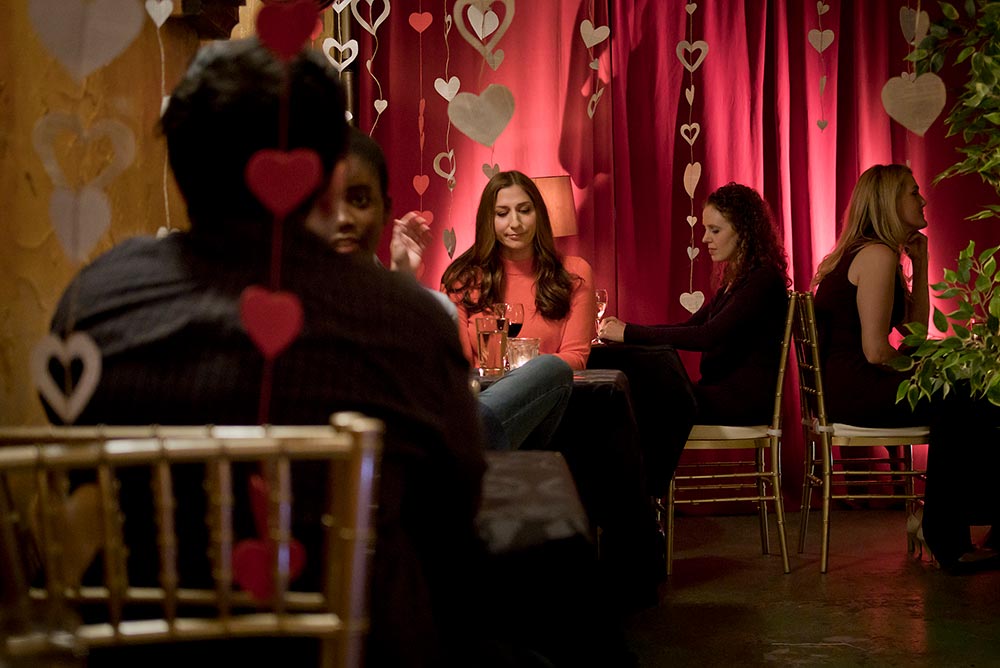
7R: Could you tell me a bit about working on Spinster with Andrea Dorfman? I love it so much. What excited you about that film?
Stéphanie Anne Weber Biron: At this point, Andrea is a friend of mine. I worked on a documentary with her for the first time years ago, and then I worked on Heartbeat. Basically, if Andrea calls me, I’m just going to say yes.
I love working with her. She’s such a beautiful soul. I know that’s a corny thing to say, but she really wants everyone working on her films to feel that they are equally important. She sees the creative process as a collaborative thing, and she wants to give everyone the space they need to be their best self and to be creative. She makes it very clear that everyone is appreciated.
I liked the script because it talks about a subject that I don’t remember really seeing talked about in many films before: that pressure that women feel to be in a couple. [There is a] pressure to be in a stable relationship, married or not, and have kids. When you’re younger, it’s less of an issue. But as you get older, you get more of that societal pressure, where you’re looked at as if something’s missing. What if someone just wants to be single? I really liked that Spinster addressed those issues, and also that it’s kind of laughing at romantic comedies.
7R: I feel like the film has all my favourite parts of romantic comedies, but without the bad politics. It’s really cozy to watch, and it looks very visually cozy, but it also doesn’t play into the same tired gender roles as a lot of rom-coms.
Stéphanie Anne Weber Biron: Exactly. That’s what I liked about it.
Also, what’s nice is that, a lot of times, films that are shot in Halifax try to pretend that they’re somewhere else. American productions coming to Nova Scotia to film, and they pretend that they’re somewhere in the States. That happens a lot. It’s great when local films showcase their own city. I love that. That’s the case in Andrea’s film. It’s shot in Halifax, and it takes place in Halifax. We showcase the city and the beautiful sea that’s nearby.
There’s one location where they go for a walk by the sea, and that is a little bit harder to access with equipment. That’s the kind of reasoning that typical productions would have to not film in a great-looking place like that. But for Andrea, this is important. This is beautiful, and she wants to show it, and so it doesn’t matter if it takes us forty minutes to hike with the equipment. We can do it. We’ll take minimal equipment, and we’ll do it. And that’s exactly what we did.
I like that about working with Andrea. I feel that she knows where to pick her battles; she knows where to insist on things that are a little bit less traditional. Typically, we’ll just choose a location that’s easier to get to so we don’t lose time, but sometimes, it’s worth it to take the extra time to get the beautiful shot of the ocean.
7R: I really liked how the film cuts harshly between the idealized romantic fantasy version of a scene to the more mundane reality — although even the “mundane reality” is still very colourful and lovely to look at. How did you think about when to use romanticized visuals?
Stéphanie Anne Weber Biron: I know that Andrea was purposely making a comment about rom coms. For Gaby, she [receives] some comments from different people along the way trying to steer her in a certain direction [toward romance]. In regards to the romantic interest that Chelsea Peretti’s character [Gaby] meets at the end, they could have walked out into the sunset together at the end. And they do literally walk into a sunset! So it was playing on that.
7R: I gather that Andrea likes to storyboard quite thoroughly. Do you like working with storyboards? And how common is that?
Stéphanie Anne Weber Biron: It’s common for specific scenes. It’s very common in advertising. But in terms of fiction films, I’ve never worked on a film that was completely storyboarded. Andrea, because she does animation films, is used to storyboarding, but even with her, I don’t think she storyboarded the whole film. But definitely, when we did a shot list, it was very convenient that she could easily do a little drawing. It’s very clear, right away, “Okay, this is what you mean.”
She wanted to emphasise food, because food is important to that character. What does food represent? It’s beyond just nutrition. It can be a source of joy and sharing and community.
We were trying to show that love is one thing, and it’s great, but there are many models [for a happy life]. Your own passions can be what makes life worthwhile. And you don’t have to be a mom yourself. For example, her relationship with her niece is very key. [Gaby] might never be a biological mother, but she has an important role in a child’s life.
7R: Spinster and Nadia, Butterfly are interesting to compare, because on one hand, you have Chelsea Peretti, who’s a seasoned actor, and then on the other hand, you have the non-professional actors, who are real-life swimmers and aren’t as comfortable with the camera. How do you collaborate with these different types of actors?
Stéphanie Anne Weber Biron: It depends on the specific actor, but I’ll try to make an effort even more with nonprofessionals or child actors, because it must be strange to have this stranger put a camera in your face all day. If I know it’s their first time, I go out of my way to explain to them some technical aspects so that they understand, “Okay, this mark on the floor is to show you where you’re supposed to be. But don’t worry about it too much. You don’t have to look at it. I prefer you not be on your mark than [the camera] sees you look at it.”
When I do get a more seasoned actor, then I can ask more specific things of them. It’s usually to be at a more precise mark so that there’s a more precise lighting effect that happens. But even in professional actors, there are some that are way more technical than others. There’s some professional actors that are amazing at finding their mark and their light, and others that you have to constantly remind, “Just put your chin up a little bit because your eyes are in shadow.”
With nonprofessionals, that is even more of an issue because you don’t want to hinder their performance. I’m more careful about not giving them too many technical instructions so that they can just focus on the acting.
Working in Canada
7R: I’m curious about your experiences working in different parts of Canada, whether that be on French Canadian productions versus English Canadian productions, or films shot in Quebec versus Halifax.
Stéphanie Anne Weber Biron: I’ve seen things evolve. I also worked on a Hollywood film shot in Canada, in Winnipeg. In Quebec, we have a strong film d’auteur because of our influence from French films, even since La Nouvelle Vague [the French New Wave] in the ’60s. That’s influenced Quebec cinema more than English Canadian cinema, although that is starting to change. I’m starting to see more strong artistic voices on the English Canadian side, for sure.
Before, the English Canadian films seemed like they were trying to be Hollywood films. There’s still that, but there’s starting to be a more indie voice in English Canadian cinema, which is great. I’ve worked with Ruth Lawrence, who’s a Newfoundland director. She’s the one who did Little Orphans, which was her first feature film. I’ve also shot a short film with her. She’s very much in that category: indie filmmaking with a vision coming from English Canada.
And then, there’s the evolution in Halifax. I’ve shot many feature films there with Andrea Dorfman, of course, who I would also put in that indie category because she still has her voice.
I find that the English Canadian side has more pressure to be like Hollywood. They will likely impose on you to get a Hollywood actor. They have this fixation that the only way to get your film seen is to attach a star to it. I understand that, and of course, it’s partially true that the fact that Chelsea Peretti is in it can be what attracts people to watch Spinster.
But I come from the more film d’auteur way of seeing things. I know that if you make a really great film, even if you have an unknown actor, and it gets into big festivals, you can get buzz around it. It can do great even without a star. That’s what is great about Quebec cinema. We don’t have that pressure of getting the Hollywood star cast. We have our own. We have some great French Canadian actors, and they all have a following here. It’s more accessible than trying to get some Hollywood actor to come on a shoestring budget. Sometimes, it works out, like for Spinster, because Chelsea said yes, and I think she was an interesting choice for that character.
In Halifax, when I went there to shoot a film for the first time, everyone there was used to shooting standard TV shows that were American. [They were shot in a] run-of-the-mill shot [reverse] shot [style]. They couldn’t understand what we were doing. The crew and the producer and the production manager were all like, “Who’s this cinematographer from Quebec? I don’t get what she’s doing.” They were questioning what me and the director were doing, because we had a very specific vision. They were very nervous about it.
Eventually, they were all on board, because I explained to the script supervisor what our vision was, and I explained to a few other key people, and they actually got really excited. It’s partially the reason why, in Halifax, I have a really great reputation, because they were impressed by the way that I approach things in a very different manner than just shooting typical coverage. Whereas in Quebec, that’s already a given. People are used to that approach.
7R: Is that what led to shooting more films in Halifax?
Stéphanie Anne Weber Biron: I think so. Because everyone was like, “Oh, did you see Blackbird? Stéphanie shot this. Look how cool it is.” Also, I think that my work with Xavier Dolan on his two first films really caught the attention of people in different parts of Canada and outside of Canada. I even got calls from Sweden and Finland and France, although those ended up not panning out for various reasons.
I was able to travel. There were not a lot of women cinematographers outside of Quebec, so I still get a lot of reactions when I travel. Not negative, usually, but just like, “Oh, it’s so cool to see a woman cinematographer.” It’s starting to change. There are more. Even in Quebec, when I started, there were not a lot at all, but I think we’re a little bit ahead of the other provinces where there are way less women cinematographers.
You could be missing out on opportunities to watch great films like Stéphanie Anne Weber Biron’s Nadia, Butterfly and Spinster at virtual cinemas, VOD, and festivals.
Subscribe to the Seventh Row newsletter to stay in the know.
Subscribers to our newsletter get an email every Friday which details great new streaming options in Canada, the US, and the UK.
Click here to subscribe to the Seventh Row newsletter.
